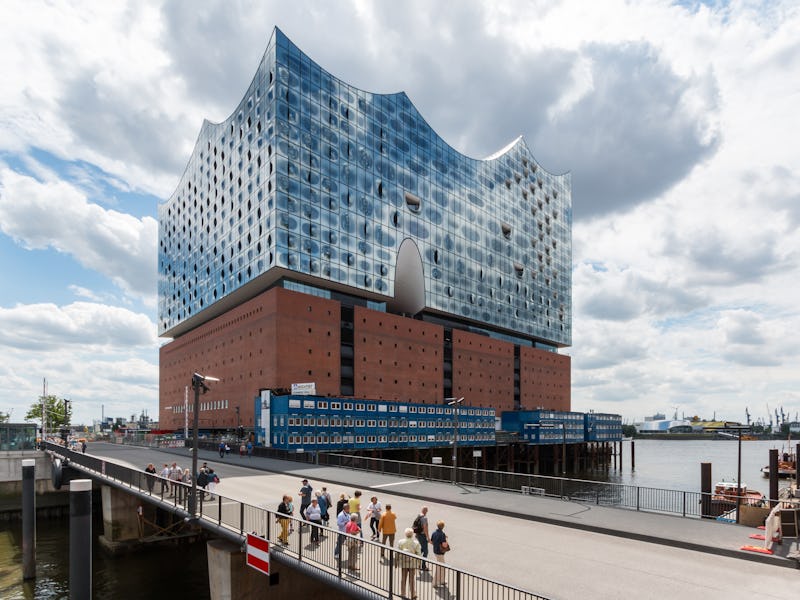Why Architects Still Can't Design Buildings for Perfect Sound
But turning our ears to Europe's concert hall boom might help.

Sound has long been an underrated aspect of modern design — just remember the troubles with the Sydney Opera House — but architects have paid more attention to it in recent decades, with structural plans focused on serving and even pleasing the ear. But when they sit down at their drawing tables around the world, architects face one big challenge: We are far from certain what type of building makes the best sound.
Take Germany’s two most recent concert halls — the Pierre Boulez Saal in Berlin and the Elbphilharmonie in Hamburg. Both were designed with input from the legendary acoustician Yasuhisa Toyota, who in 2013 famously told Venues Today:
“We can make the small, physical model and make actual sounds in it to test and avoid echoes. We test with those small-scale models before, make adjustments, and after that all we can do is just pray.”
Despite the common thread of Toyota’s acoustic planning, the two new halls are drastically different spaces — and one seems a little less mystical than the other.
The Pierre Boulez Saal relies on natural materials to give its orchestra that extra oompf. It’s an intimate space, arranged in an oval and made of undulating panels of Douglas fir. The use of wood was a surprise to many, as its notorious for producing heavy echoes. But Toyota tinkered with the height of the hall’s upper levels, the LA Times reports. And, experts say, wood can be texturized to reduce its worst sounds, though it’s unclear if that happened with the saal.
The futuristic, first-of-its-kind Elbphilharmonie, by contrast, was meticulously managed with math. A work of parametric architecture, designer Benjamin Koren used an algorithm to predict and shape the relationship between the space and the people using it.
Opening night at the Elbphilharmonie in Hamburg, Germany in January.
Specifically, he tells Inverse, he coded a program that produced 10,000 sound-amplifying gypsum fiber panels. Each panel is unique, so it shapes sound differently. Together, though, the approximately one million divots create an even sound across the entire auditorium.
But the programming didn’t start from scratch. Koren spoke with Toyota first. “Toyota gave very concrete and specific requirements, Koren says, “but it wasn’t down to the level of, you know, these cells… He just defined broad surfaces.” For example, Toyota knew from experience that panels in the back would have to be deeper than those in the front, to help the sound to carry through the hall. Koren’s design executed — down to the centimeter.
While it takes months to get the final judgment on whether a hall’s sound works or not, both German halls have been well received. But the LA Times wrote that, in the end:
The Elbphilharmonie is the concert hall that Hamburg needs. The Pierre Boulez Saal is what the world needs.
And that reveals the strange and exciting truth of where the science of sound is today. Math and modeling are catching up fast, but acoustics remains largely unchartered territory. And individual taste — the way you vibe with a space or don’t — is as important as ever.
Still, Shea Trahan, an architect with a passion for neuroscience, remains convinced design for the ear will one day come to match the precision of design for the eye. “[I]n the spectrum of my career, I expect to see dramatic advances in… architectural acoustics,” he tells Inverse. “The way sound moves in a space is much more complex and much harder to accurate move and control [than light]. That being said, technology is catching up with us, right?”
Right.
But maybe don’t stop praying just yet.
4 More Of the World’s Wildest Concert Halls
The Weiner Musikverein in Vienna, Austria opened in 1870.
The Wiener Musikverein in Vienna, Austria performs similarly to the Elbphilharmonie, WIRED reports, because the Musikverein’s intricate neoclassical details create a diffusion effect like the Elbphilharmonie’s algorithmic panels.
Designed by Frank Gehry, the Walt Disney Concert Hall in Los Angeles opened in 2003.
The Walt Disney Concert Hall in Los Angeles was also designed by Frank Gehry. While the Pierre Boulez Saal clearly has Gehry’s fingerprints on it, this hall is the architect in peak form. Made from harsh metals, it comes alive thanks to its undulating shapes.
The Paris Philharmonie.
The spaceship-esque Paris Philharmonie has one of the most troublesome construction stories in recent memory. As The Guardian reported at the time, the hall was two years late and extremely over budget.
Nothing to drool over from the outside. But inside, Tokyo Opera City is something special to behold.
Tokyo Opera City looks like any other skyscraper. But take a peek inside its concert hall and you’ll find a blend of the Pierre Boulez Saal’s warm woods and the Elbphilharmonie’s futurism.